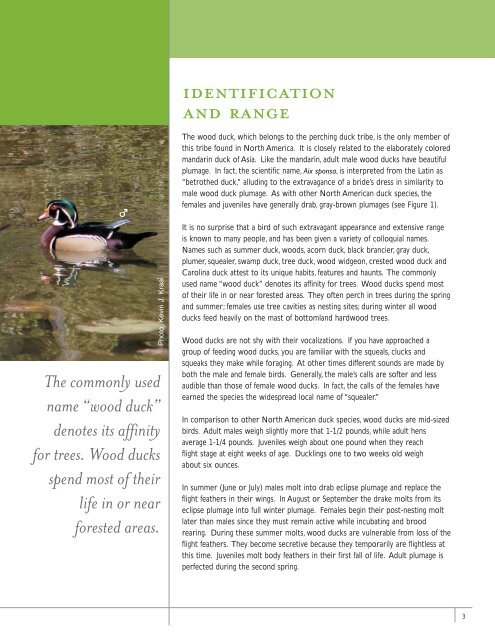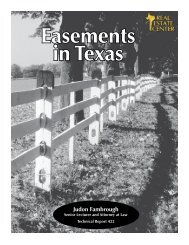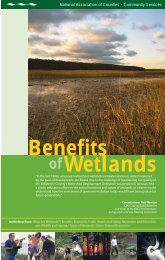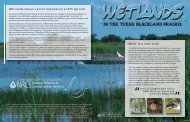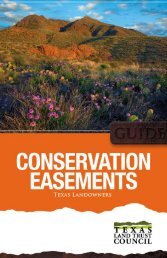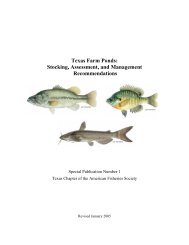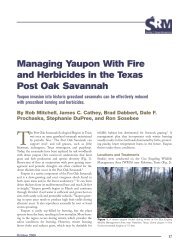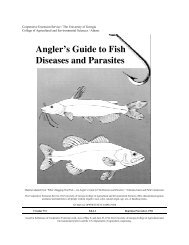Managing for Wood Ducks in East Texas - Trinity Waters
Managing for Wood Ducks in East Texas - Trinity Waters
Managing for Wood Ducks in East Texas - Trinity Waters
You also want an ePaper? Increase the reach of your titles
YUMPU automatically turns print PDFs into web optimized ePapers that Google loves.
IDENTIFICATION<br />
AND RANGE<br />
The wood duck, which belongs to the perch<strong>in</strong>g duck tribe, is the only member of<br />
this tribe found <strong>in</strong> North America. It is closely related to the elaborately colored<br />
mandar<strong>in</strong> duck of Asia. Like the mandar<strong>in</strong>, adult male wood ducks have beautiful<br />
plumage. In fact, the scientific name, Aix sponsa, is <strong>in</strong>terpreted from the Lat<strong>in</strong> as<br />
“betrothed duck,” allud<strong>in</strong>g to the extravagance of a bride’s dress <strong>in</strong> similarity to<br />
male wood duck plumage. As with other North American duck species, the<br />
females and juveniles have generally drab, gray-brown plumages (see Figure 1).<br />
Photo: Kev<strong>in</strong> J. Kraai<br />
The commonly used<br />
name “wood duck”<br />
denotes its aff<strong>in</strong>ity<br />
<strong>for</strong> trees. <strong>Wood</strong> ducks<br />
spend most of their<br />
life <strong>in</strong> or near<br />
<strong>for</strong>ested areas.<br />
It is no surprise that a bird of such extravagant appearance and extensive range<br />
is known to many people, and has been given a variety of colloquial names.<br />
Names such as summer duck, woods, acorn duck, black brancier, gray duck,<br />
plumer, squealer, swamp duck, tree duck, wood widgeon, crested wood duck and<br />
Carol<strong>in</strong>a duck attest to its unique habits, features and haunts. The commonly<br />
used name “wood duck” denotes its aff<strong>in</strong>ity <strong>for</strong> trees. <strong>Wood</strong> ducks spend most<br />
of their life <strong>in</strong> or near <strong>for</strong>ested areas. They often perch <strong>in</strong> trees dur<strong>in</strong>g the spr<strong>in</strong>g<br />
and summer; females use tree cavities as nest<strong>in</strong>g sites; dur<strong>in</strong>g w<strong>in</strong>ter all wood<br />
ducks feed heavily on the mast of bottomland hardwood trees.<br />
<strong>Wood</strong> ducks are not shy with their vocalizations. If you have approached a<br />
group of feed<strong>in</strong>g wood ducks, you are familiar with the squeals, clucks and<br />
squeaks they make while <strong>for</strong>ag<strong>in</strong>g. At other times different sounds are made by<br />
both the male and female birds. Generally, the male’s calls are softer and less<br />
audible than those of female wood ducks. In fact, the calls of the females have<br />
earned the species the widespread local name of “squealer.”<br />
In comparison to other North American duck species, wood ducks are mid-sized<br />
birds. Adult males weigh slightly more that 1-1/2 pounds, while adult hens<br />
average 1-1/4 pounds. Juveniles weigh about one pound when they reach<br />
flight stage at eight weeks of age. Duckl<strong>in</strong>gs one to two weeks old weigh<br />
about six ounces.<br />
In summer (June or July) males molt <strong>in</strong>to drab eclipse plumage and replace the<br />
flight feathers <strong>in</strong> their w<strong>in</strong>gs. In August or September the drake molts from its<br />
eclipse plumage <strong>in</strong>to full w<strong>in</strong>ter plumage. Females beg<strong>in</strong> their post-nest<strong>in</strong>g molt<br />
later than males s<strong>in</strong>ce they must rema<strong>in</strong> active while <strong>in</strong>cubat<strong>in</strong>g and brood<br />
rear<strong>in</strong>g. Dur<strong>in</strong>g these summer molts, wood ducks are vulnerable from loss of the<br />
flight feathers. They become secretive because they temporarily are flightless at<br />
this time. Juveniles molt body feathers <strong>in</strong> their first fall of life. Adult plumage is<br />
perfected dur<strong>in</strong>g the second spr<strong>in</strong>g.<br />
3


